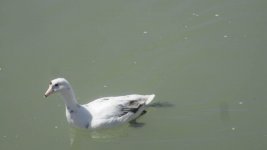Today I saw something that I've never seen before: a white American coot. The coot is white, not an albino (its eyes are dark colored and it has some black patches and spots). I've seen many coots over numerous decades all across the U.S. and parts of Canada and this is the first white one that I've seen. There are no closely related species here (notably, none of the same genus) so hybridization can essentially be ruled out as a cause for this unique color. It appears most likely that a deviation in the gene(s) associated with colorization is responsible for this individual's white color. The bird was seen in company with several standard black coots and its behavior was typical for a coot. Though apparently rare, one would expect that this mutant coot color is something that repeatedly occurs at some low frequency so I wonder how many other readers here have seen a white American coot?
Unfortunately, I didn't have a camera with me. However, a person who also saw this coot said she might go home and return with her camera and if able to photograph it, would post it on this website. So, let's hope that she had good luck.
Unfortunately, I didn't have a camera with me. However, a person who also saw this coot said she might go home and return with her camera and if able to photograph it, would post it on this website. So, let's hope that she had good luck.







